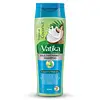Dabur Vatika Naturals Multivitamin+ Shampoo Versus Garnier Ultra Doux Argan Oil And Cranberry Conditioner
What's inside
What's inside
 Key Ingredients
Key Ingredients

 Benefits
Benefits

 Concerns
Concerns

 Ingredients Side-by-side
Ingredients Side-by-side

Water
Skin ConditioningSodium Laureth Sulfate
CleansingDimethiconol
EmollientCocamide Mea
EmulsifyingCocamidopropyl Betaine
CleansingGlycol Distearate
EmollientParfum
MaskingSodium Chloride
MaskingAmodimethicone
Sodium PCA
HumectantCarbomer
Emulsion StabilisingGuar Hydroxypropyltrimonium Chloride
Skin ConditioningLawsonia Inermis Leaf Extract
Skin ConditioningPanthenol
Skin ConditioningSodium Hydroxide
BufferingDisodium EDTA
Hydrolyzed Vegetable Protein
Skin ConditioningIsopropyl Laurate
EmollientIsopropyl Myristate
EmollientIsopropyl Palmitate
EmollientIsopropyl Stearate
EmollientIsopropyl Oleate
EmollientRicinus Communis Seed Oil
MaskingGlycine Soja Oil
EmollientCarthamus Tinctorius Seed Oil
MaskingLinoleic Acid
CleansingRetinyl Palmitate
Skin ConditioningTocopheryl Acetate
AntioxidantPEG-90m
Emulsion StabilisingLactic Acid
BufferingTea-Dodecylbenzenesulfonate
CleansingTrideceth-12
EmulsifyingCetrimonium Chloride
AntimicrobialPropylene Glycol
HumectantPhenoxyethanol
PreservativeMethylparaben
PreservativeEthylparaben
PreservativePropylparaben
PreservativeButylparaben
MaskingMagnesium Nitrate
Magnesium Chloride
Methylchloroisothiazolinone
PreservativeMethylisothiazolinone
PreservativeAmyl Cinnamal
PerfumingLimonene
PerfumingLinalool
PerfumingWater, Sodium Laureth Sulfate, Dimethiconol, Cocamide Mea, Cocamidopropyl Betaine, Glycol Distearate, Parfum, Sodium Chloride, Amodimethicone, Sodium PCA, Carbomer, Guar Hydroxypropyltrimonium Chloride, Lawsonia Inermis Leaf Extract, Panthenol, Sodium Hydroxide, Disodium EDTA, Hydrolyzed Vegetable Protein, Isopropyl Laurate, Isopropyl Myristate, Isopropyl Palmitate, Isopropyl Stearate, Isopropyl Oleate, Ricinus Communis Seed Oil, Glycine Soja Oil, Carthamus Tinctorius Seed Oil, Linoleic Acid, Retinyl Palmitate, Tocopheryl Acetate, PEG-90m, Lactic Acid, Tea-Dodecylbenzenesulfonate, Trideceth-12, Cetrimonium Chloride, Propylene Glycol, Phenoxyethanol, Methylparaben, Ethylparaben, Propylparaben, Butylparaben, Magnesium Nitrate, Magnesium Chloride, Methylchloroisothiazolinone, Methylisothiazolinone, Amyl Cinnamal, Limonene, Linalool
Water
Skin ConditioningCetearyl Alcohol
EmollientDicetyldimonium Chloride
EmulsifyingCetrimonium Chloride
AntimicrobialArgania Spinosa Kernel Oil
EmollientVaccinium Macrocarpon Seed Oil
Skin ConditioningSteareth-6
EmulsifyingTrideceth-10
CleansingTrideceth-3
EmulsifyingAmodimethicone
Dimethicone
EmollientPEG-100 Stearate
Isopropyl Alcohol
SolventTrisodium Hedta
Acetic Acid
BufferingTartaric Acid
BufferingCetyl Esters
EmollientSodium Benzoate
MaskingPhenoxyethanol
PreservativeChlorhexidine Digluconate
AntimicrobialLinalool
PerfumingLimonene
PerfumingCitronellol
PerfumingBenzyl Alcohol
PerfumingBenzyl Salicylate
PerfumingParfum
MaskingWater, Cetearyl Alcohol, Dicetyldimonium Chloride, Cetrimonium Chloride, Argania Spinosa Kernel Oil, Vaccinium Macrocarpon Seed Oil, Steareth-6, Trideceth-10, Trideceth-3, Amodimethicone, Dimethicone, PEG-100 Stearate, Isopropyl Alcohol, Trisodium Hedta, Acetic Acid, Tartaric Acid, Cetyl Esters, Sodium Benzoate, Phenoxyethanol, Chlorhexidine Digluconate, Linalool, Limonene, Citronellol, Benzyl Alcohol, Benzyl Salicylate, Parfum
Ingredients Explained
These ingredients are found in both products.
Ingredients higher up in an ingredient list are typically present in a larger amount.
This water-soluble silicone is used for its hydrating and softening properties. It is used to add a silky feel to skincare products and has great benefits for haircare.
In haircare, this ingredient:
- Adds shine
- Protects color
- Offers thermal protection
- Boosts hair strength
- Does not build up as easily
This ingredient is a preservative, antimicrobial, and emulsifier. It is often used in cosmetics for its ability to cleanse, condition, and reduce static.
Cetrimonium chloride is a quaternary ammonium salt, meaning it has a water-soluble structure.
Limonene is a fragrance that adds scent and taste to a formulation.
It's found in the peel oil of citrus fruits and other plants such as lavender and eucalyptus. The scent of limonene is generally described as "sweet citrus".
Limonene acts as an antioxidant, meaning it helps neutralize free radicals.
When exposed to air, oxidized limonene may sensitize the skin. Because of this, limonene is often avoided by people with sensitive skin.
The term 'fragrance' is not regulated in many countries. In many cases, it is up to the brand to define this term. For instance, many brands choose to label themselves as "fragrance-free" because they are not using synthetic fragrances. However, their products may still contain ingredients such as essential oils that are considered a fragrance.
Learn more about LimoneneLinalool is a fragrance and helps add scent to products. It's derived from common plants such as cinnamon, mint, citrus, and lavender.
Like Limonene, this ingredient oxidizes when exposed to air. Oxidized linalool can cause allergies and skin sensitivity.
This ingredient has a scent that is floral, spicy tropical, and citrus-like.
Learn more about LinaloolParfum is a catch-all term for an ingredient or more that is used to give a scent to products.
Also called "fragrance", this ingredient can be a blend of hundreds of chemicals or plant oils. This means every product with "fragrance" or "parfum" in the ingredients list is a different mixture.
For instance, Habanolide is a proprietary trade name for a specific aroma chemical. When used as a fragrance ingredient in cosmetics, most aroma chemicals fall under the broad labeling category of “FRAGRANCE” or “PARFUM” according to EU and US regulations.
The term 'parfum' or 'fragrance' is not regulated in many countries. In many cases, it is up to the brand to define this term.
For instance, many brands choose to label themselves as "fragrance-free" because they are not using synthetic fragrances. However, their products may still contain ingredients such as essential oils that are considered a fragrance by INCI standards.
One example is Calendula flower extract. Calendula is an essential oil that still imparts a scent or 'fragrance'.
Depending on the blend, the ingredients in the mixture can cause allergies and sensitivities on the skin. Some ingredients that are known EU allergens include linalool and citronellol.
Parfum can also be used to mask or cover an unpleasant scent.
The bottom line is: not all fragrances/parfum/ingredients are created equally. If you are worried about fragrances, we recommend taking a closer look at an ingredient. And of course, we always recommend speaking with a professional.
Learn more about ParfumPhenoxyethanol is a preservative that has germicide, antimicrobial, and aromatic properties. Studies show that phenoxyethanol can prevent microbial growth. By itself, it has a scent that is similar to that of a rose.
It's often used in formulations along with Caprylyl Glycol to preserve the shelf life of products.
Water. It's the most common cosmetic ingredient of all. You'll usually see it at the top of ingredient lists, meaning that it makes up the largest part of the product.
So why is it so popular? Water most often acts as a solvent - this means that it helps dissolve other ingredients into the formulation.
You'll also recognize water as that liquid we all need to stay alive. If you see this, drink a glass of water. Stay hydrated!
Learn more about Water